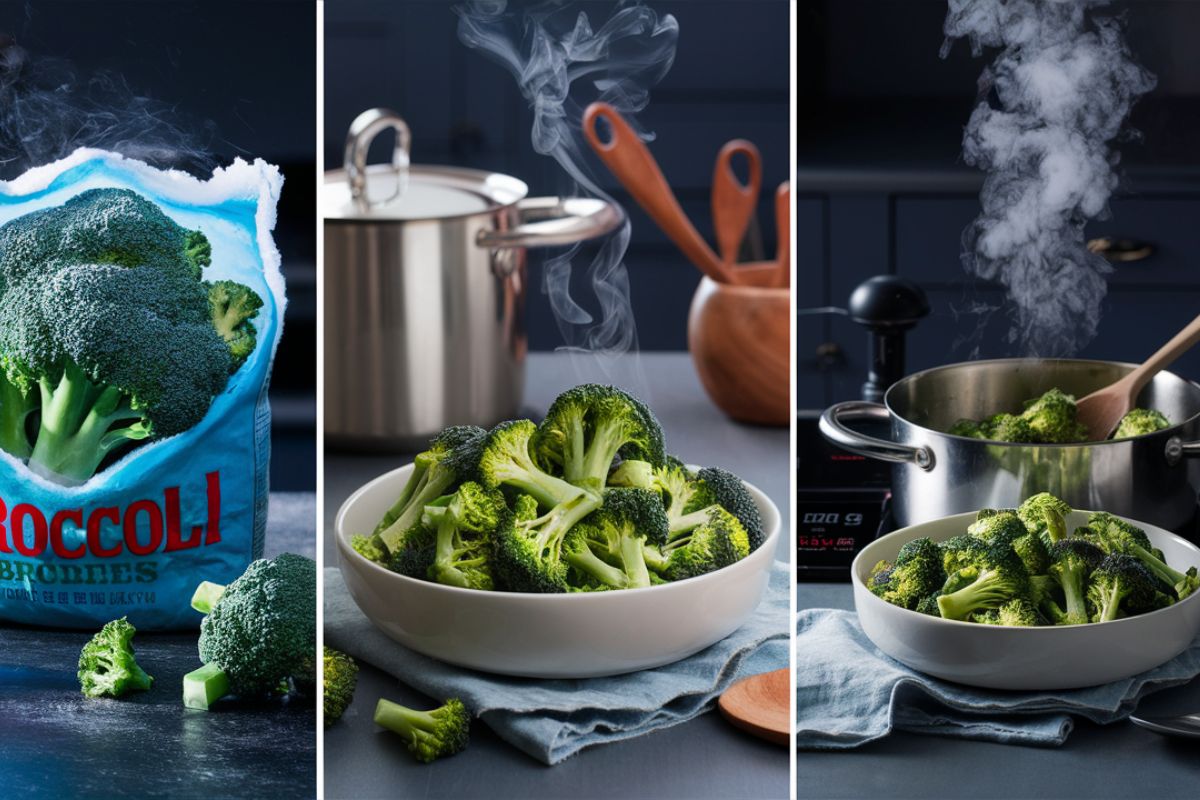Frozen broccoli isn’t just a staple in the freezer; it’s a powerhouse of nutrition and convenience that suits any meal. Whether you’re tossing it into a stir-fry or steaming it as a side, it maintains its health benefits and taste, making it a wise choice for health-conscious individuals and busy families alike. In this article, we delve into the numerous advantages of frozen broccoli, offer guidance on selection and storage, and share some enticing ways to prepare it. Let’s begin with understanding what frozen broccoli is and why it’s a viable alternative to its fresh counterpart.
What is Frozen Broccoli?
Frozen broccoli is prepared from fresh broccoli, blanched, and frozen quickly after harvesting to preserve its nutritional value, texture, and flavor. This process ensures that the broccoli remains as close to its natural state as possible. Unlike fresh broccoli, which can degrade in nutritional quality over time, the quick-freezing process locks in vitamins and minerals, making frozen broccoli a nutritious option year-round.
Why Choose Frozen Over Fresh?
There are several compelling reasons to opt for frozen broccoli over fresh. Firstly, it is often more economical, especially when fresh broccoli prices spike due to seasonal changes or supply issues. Additionally, frozen broccoli offers unmatched convenience; it’s pre-cut, washed, and ready to cook, saving precious prep time in the kitchen.
Moreover, the nutritional retention in frozen broccoli makes it a smart choice. The freezing process helps preserve essential nutrients such as vitamin C, vitamin K, and dietary fiber, which are crucial for maintaining good health. Research shows that frozen vegetables can be just as nutritious as their fresh counterparts, sometimes even more so.
So, whether you’re looking to enhance your diet with more greens or seeking a convenient cooking shortcut, frozen broccoli proves to be a versatile and worthy addition to any kitchen.
Benefits and Nutritional Value
Frozen broccoli is not just convenient; it’s a powerhouse of essential nutrients. Let’s explore the specific nutritional benefits of this versatile vegetable and why it should be a regular part of your diet.
Nutritional Comparison: Frozen vs. Fresh Broccoli
The debate between fresh and frozen broccoli often centers on nutrient content. Studies suggest that frozen broccoli can retain nutrients better than fresh, especially if the fresh variety has been stored for too long. Frozen broccoli is blanched and frozen within hours of harvesting. This process helps lock in vitamins and minerals. It keeps high levels of vitamin C, vitamin K, and dietary fiber, which support bone health, immune function, and digestion.
Moreover, the quick freezing process helps preserve water-soluble nutrients, such as B-vitamins and vitamin C. These nutrients can degrade when fresh vegetables are exposed to air, light, or heat. Therefore, frozen broccoli is not only practical but also nutritious.
Health Benefits of Frozen Broccoli
Adding frozen broccoli to your meals offers significant health benefits. It’s rich in sulforaphane, a compound with potent anti-inflammatory and cancer-preventive properties. Regularly eating broccoli can lower the risk of chronic diseases such as heart disease, hypertension, and several types of cancer.
Frozen broccoli also aids in weight management. It’s low in calories yet high in fiber, making it a filling choice that can help control appetite and support weight loss. This fiber also promotes healthy digestion and can help reduce cholesterol levels.
Additionally, the convenience of frozen broccoli makes it easier to eat vegetables more often. This is especially true for those who might not have time to prepare fresh produce. By including this nutrient-dense vegetable in your diet, you are taking a step towards a healthier lifestyle without sacrificing taste or nutrition.
How to Select and Store Frozen Broccoli
Choosing and maintaining the quality of frozen broccoli is crucial for enjoying its best flavor and nutritional benefits. Here’s how you can ensure you’re getting the most out of this versatile vegetable.
Tips for Selecting the Best Frozen Broccoli
When shopping for frozen broccoli, look for packages that are firm to the touch. This indicates that the broccoli was frozen quickly and has remained solid, preventing ice crystals from forming. Ice crystals can signify thawing and refreezing, which degrades quality and texture. Also, avoid packages that have visible frost or ice inside, as this could mean the broccoli has been stored for a long time.
Additionally, check the ingredients list on the package. Opt for frozen broccoli that contains no added salts, sugars, or preservatives. This choice ensures you’re buying the most natural and healthful product.
Best Practices for Storing Frozen Broccoli
Once home, store your frozen broccoli in the freezer immediately. Keeping it at a consistent temperature will preserve its quality and prevent spoilage. Ideally, your freezer should be set at 0°F (-18°C) or lower, which is the optimal temperature for storing frozen foods.
If you have a large amount of frozen broccoli, consider dividing it into smaller portions before freezing. This method avoids having to thaw all the broccoli if you only need a small amount. Re-freezing thawed vegetables can affect their texture and nutritional quality.
Using these selection and storage techniques will help maintain the integrity of your frozen broccoli. This ensures it remains delicious and nutritious whenever you choose to use it in your cooking.
Cooking with Frozen Broccoli
Cooking with frozen broccoli is both an art and a science, ensuring that its nutritional benefits are preserved while enhancing its natural flavors. Here are some of the best ways to cook frozen broccoli and a few innovative recipes to inspire your culinary adventures.
How to Cook Frozen Broccoli
The key to cooking frozen broccoli is to minimize water exposure, which can leach out nutrients and lead to soggy results. Steaming is one of the most effective methods. It preserves the texture and maximizes nutrient retention:
- Steaming: Place frozen broccoli in a steamer basket over boiling water. Cover and steam for about 5 to 6 minutes until it is tender yet crisp.
- Microwaving: This can be a quick and efficient method. Place frozen broccoli in a microwave-safe dish, add a tablespoon of water, cover, and microwave on high for about 3 to 4 minutes.
- Sautéing: Heat a small amount of olive oil in a skillet over medium heat. Add the frozen broccoli, and cook, stirring occasionally, until it is heated through and slightly browned, about 6 to 8 minutes.
Each of these methods ensures that you keep the robust flavors and healthful qualities of frozen broccoli, making it a versatile addition to any meal.
Innovative Recipes Using Frozen Broccoli
Frozen broccoli is incredibly versatile in recipes. Here are a few creative ways to incorporate it into your diet:
- Broccoli and Cheddar Soup: Blend steamed frozen broccoli with a creamy cheese base for a comforting winter soup.
- Broccoli Stir-fry: Sauté frozen broccoli with a mix of other vegetables, soy sauce, and your choice of protein for a quick and healthy stir-fry.
- Broccoli Pesto Pasta: Use steamed frozen broccoli to make a green pesto sauce, then mix it with your favorite pasta for a nutritious meal.
By experimenting with frozen broccoli in these recipes, you can enjoy a gourmet meal experience that is both delicious and healthful.
Common Misconceptions About Frozen Broccoli
Frozen broccoli often faces misconceptions that can discourage people from incorporating it into their diets. Let’s debunk some of these myths and clarify why it is a healthy, convenient, and versatile choice for anyone.
Debunking Myths Related to Frozen Foods
Myth 1: Frozen vegetables are less nutritious than fresh vegetables. Contrary to popular belief, it can be just as nutritious, if not more so, than fresh broccoli. The freezing process actually helps preserve vitamins and minerals, ensuring that it retains its health benefits.
Myth 2: Cooking it results in loss of flavor and texture. While improper cooking can indeed affect texture and flavor, using the right techniques can make it taste just as good as fresh. Methods like steaming, microwaving, and sautéing preserve its integrity and flavor.
Myth 3: It contains additives and preservatives. Most frozen broccoli is free of additives and preservatives. It’s important to read the package to ensure you’re choosing a product that contains only broccoli without added ingredients.
Understanding these truths can change the way you view and use this frozen vegetable in your daily cooking. It’s not just a backup option for when you’re out of fresh vegetables; it’s a staple that deserves a regular spot in your freezer.
Sustainable and Seasonal Benefits
Environmental Impact of Choosing Frozen
Frozen broccoli offers several environmental benefits that make it an appealing choice for those looking to reduce their ecological footprint. By freezing broccoli, producers can extend the availability of the vegetable beyond its natural growing season, which reduces waste and the need for out-of-season imports. This section can discuss how frozen broccoli minimizes food spoilage and reduces the frequency of grocery shopping, contributing to lower carbon emissions associated with transportation.
Seasonal Eating and Frozen Broccoli
While many advocate for eating seasonally, frozen broccoli provides a practical solution for enjoying vegetables year-round without compromising on nutritional quality or taste. This part can explore how incorporating frozen broccoli into your diet helps maintain a balanced diet even when certain fresh vegetables are not in season. Additionally, it can highlight how using frozen produce can complement fresh seasonal eating by providing nutritional diversity throughout the year.
FAQs about Frozen Broccoli
Conclusion
Summary of Benefits and Uses
This versatile vegetable stands out as a stellar choice for those seeking convenience without sacrificing nutritional value. It’s packed with essential nutrients, all preserved through the quick-freezing process. This makes it not only a practical but also a healthful option, ready to be included in a variety of dishes.
Whether used in soups, stir-fries, or as a nutritious side, it offers a wealth of culinary possibilities. Its ease of preparation makes it ideal for busy lifestyles, ensuring that a healthy meal is always within reach.
Final Thoughts on Incorporating It into Your Diet
Incorporating it into your diet is an excellent way to boost your intake of essential nutrients. It adapts well to numerous cooking methods, proving itself as more than just a backup for fresh produce. By choosing this frozen vegetable, you’re embracing a convenient, affordable, and nutritious option that can elevate your meals and support your health.
Embrace the versatility and benefits to make your meals healthier, tastier, and more convenient. With all these advantages, it’s clear why this vegetable deserves a regular place in your freezer and on your plate.

